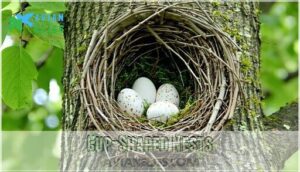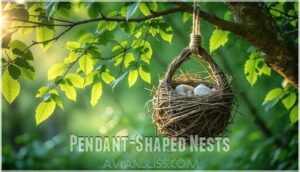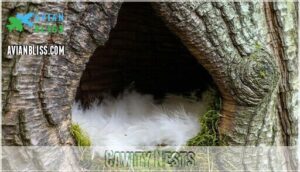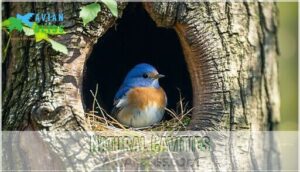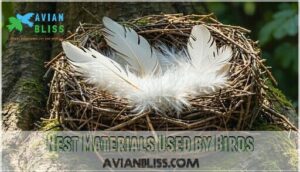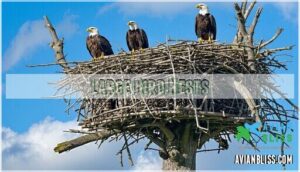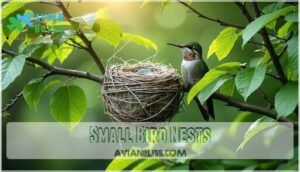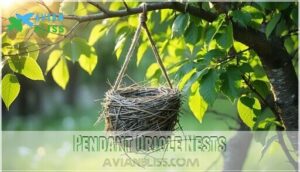This site is supported by our readers. We may earn a commission, at no cost to you, if you purchase through links.
 You’ll find that birds build nests in countless ways, like nature’s own architects. Most nests serve as cradles for eggs and young chicks, protecting them from predators and weather.
You’ll find that birds build nests in countless ways, like nature’s own architects. Most nests serve as cradles for eggs and young chicks, protecting them from predators and weather.
Materials vary widely – from twigs and grass to mud, spider silk, and even your dryer lint! Some birds create simple cup shapes while others, like orioles, weave hanging pouches that would make a master craftsman jealous.
Bald eagles construct massive platforms weighing up to a ton, while hummingbirds make thimble-sized nests using spider webs as flexible binding. The smallest nests belong to bee hummingbirds – no bigger than a quarter.
Wait until you see how some birds decorate!
Table Of Contents
- Key Takeaways
- Why Do Birds Build Nests
- Types of Bird Nests
- Bird Nest Locations
- Nest Materials Used by Birds
- Large Bird Nests
- Small Bird Nests
- Pendant Oriole Nests
- Scrape Nests
- Underground Bird Nests
- How to Keep Birds From Building Nests
- Frequently Asked Questions (FAQs)
- What does a nest do for birds?
- Why do birds build nests?
- How strong is a bird’s nest?
- Do birds build nests?
- What are bird nest facts?
- What is bird nest identification?
- Why should you explore the different types of bird nests?
- How fast do birds build nests?
- Why do birds build a nest and not use it?
- How long will a mother bird leave her nest?
- Conclusion
Key Takeaways
- You’ll find birds use a remarkable variety of materials for their nests, from natural items like twigs and moss to human-made materials like string and foil, with spider silk often serving as nature’s glue.
- Bird nests come in five main types: cup-shaped, pendant, dome-shaped, platform, and cavity nests, each designed to protect eggs and young in different environments while showcasing birds’ natural engineering skills.
- You’ll see dramatic size differences in bird architecture, from massive bald eagle nests weighing up to two tons to tiny hummingbird homes smaller than a quarter that use spider webs for flexibility.
- Birds choose nesting locations based on safety from predators and proximity to food sources, building in diverse spots from high treetops and cliff edges to underground burrows and human structures, demonstrating their remarkable variety of adaptations and diverse spots for nesting.
Why Do Birds Build Nests
You’ll find birds build nests primarily to protect their eggs and raise their young in a safe environment, much like how you’d create a nursery for a baby.
These specialized structures, crafted from materials ranging from twigs and grass to spider webs and feathers, provide essential shelter from predators and harsh weather conditions during the vulnerable breeding season.
Nest Function
Every spring, countless birds undertake the essential task of nest building. These aren’t just simple homes—they serve five critical functions: egg incubation, chick rearing, predator protection, thermal regulation, and shelter from harsh weather.
A well-built nest maintains perfect humidity and temperature for developing eggs.
After breeding season, you’ll notice nest abandonment as birds move on, though some species will return to successful nest sites year after year.
Nest Materials
Beyond their instinctive drive to shelter eggs, birds are incredible architects in the area of nest materials.
You’ll be amazed at what they collect! Natural materials like twigs, grass, and moss form the foundation, while spider webs serve as nature’s glue, binding everything together.
For nest insulation, birds carefully select soft materials including feathers, fur, and plant down.
Material acquisition varies by species—some use mud as cement, while others in urban settings incorporate string or paper.
Birds even consider material durability and camouflage materials to protect their homes from predators. Their resourcefulness in bird nest building is truly remarkable!
Nesting Locations
Birds choose nesting locations based on safety, food availability, and shelter from weather.
You’ll find these homes in unexpected places:
- Urban nests tucked into gutters, vents, and even traffic lights
- Cliffside habitats providing safety from ground predators
- Ground nests hidden in tall grass or sandy beaches
Some birds prefer towering heights (bald eagles nest up to 140 feet high), while others burrow underground. From suburban backyards to remote wilderness, these nesting sites showcase birds’ remarkable adaptability to their environment.
Types of Bird Nests
You’ll find that birds build five main types of nests: cup-shaped, pendant, dome-shaped, platform, and cavity nests, each designed to protect eggs and young in different environments.
From the tiny cup nests of hummingbirds to the massive stick platforms of eagles, these remarkable structures showcase birds’ natural engineering skills without any formal training, highlighting their natural ability to adapt and build.
Cup-Shaped Nests
Cup-shaped nests, nature’s favorite design, resemble your morning coffee mug in shape.
I’ll create a short, engaging blockquote in the same tone as the paragraph you shared about cup-shaped nests.
Nature’s favorite design: cup nests cradle new life like your morning coffee mug holds comfort.
These cozy bowls are constructed from twigs, grass, and moss, showcasing impressive nest construction techniques. Robins and finches excel at creating these structures, carefully weaving nest materials for durability.
The outer layer provides camouflage, while the inside is lined with softer materials like feathers or plant down.
Nest dimensions vary by species, creating perfect protection from nest predators, with an emphasis on durability.
Pendant-Shaped Nests
While cup nests cradle eggs in a bowl shape, pendant-shaped nests hang like nature’s hammocks from branches, offering superior predator defense.
Here’s what makes these hanging homes remarkable:
- Woven from flexible materials like grasses, twine, and horsehair
- Typically dangling from tree branches’ outermost tips
- Shaped like pouches or tubes that swing in the wind
- Built primarily by orioles using intricate weaving techniques
- Lined with soft materials for insulation and comfort
You’ll often spot these architectural wonders swaying gently in trees. Birds use spider silk elasticity for added strength, creating a natural defense.
Dome-Shaped Nests
Inside dome-shaped nests, birds enjoy a perfect combination of safety and comfort.
These enclosed structures function like tiny fortresses against both weather and hungry predators.
| Bird Species | Construction Material | Nest Camouflage |
|---|---|---|
| Marsh Wren | Reeds and sedges | Blends with marsh vegetation |
| Meadowlark | Woven grasses | Hidden in grassland |
| Winter Wren | Moss and twigs | Camouflaged against forest floor |
You’ll find these architectural marvels especially well-designed for temperature regulation and predator avoidance.
Platform Nests
Atop the highest trees, platform nests stand as nature’s skyscrapers.
These flat, open structures are built by larger birds like eagles, hawks, and osprey.
You’ll marvel at their impressive size—some reaching 6 feet across and weighing up to a ton!
Crafted from sturdy sticks and branches, their structural integrity withstands harsh weather while supporting growing families.
Many platform nests are reused yearly, gradually expanding with each breeding season.
Cavity Nests
Cavity nests offer birds the ultimate natural protection, like having a security system built into their homes.
You’ll find woodpeckers drilling custom-sized holes in trees, while chickadees and bluebirds move into these "pre-owned" woodpecker homes.
Birds line these shelters with soft materials like moss and feathers.
The nest location varies by species variation – from tiny nuthatches to larger owls – each preferring different cavity sizes for their nest building needs.
Bird Nest Locations
You’ll find bird nests in surprising spots from natural tree cavities and cliffside ledges to your gutters and kitchen vents.
Birds select these locations based on what’s safe from predators and close to food and water sources, much like you’d choose an apartment with good security and nearby grocery stores, considering factors that make a location convenient.
Natural Cavities
Many birds avoid building nests from scratch by choosing natural cavities as ready-made homes.
These resourceful cavity dwellers seek out:
- Tree hollows created by decay or lightning strikes
- Rock crevices that offer protection from wind and rain
- Abandoned woodpecker holes that provide perfect nest locations
You’ll find bluebirds, titmice, and owls taking advantage of these natural shelters, often adding soft materials for comfort while enjoying built-in protection from predators and harsh weather, which makes them perfect nest locations.
Human-Made Structures
While natural cavities offer shelter, birds have adapted brilliantly to our human landscape.
You’ll spot these resourceful architects incorporating our structures into their nest locations:
- Barn swallows gluing mud nests onto vertical walls of buildings
- Eastern bluebirds claiming artificial nest boxes in suburban yards
- Winter wrens tucking homes into hanging flower baskets
- Sociable weavers building massive community apartments on telephone poles
As cities expand, these adaptable birds increasingly use human-made materials like string, foil, and even clothing pieces to strengthen their urban nesting sites. Consider buying bird houses to support local bird populations, and notice how birds are resourceful architects incorporating our structures into their nest locations, making them adaptable birds that use human-made materials, and how they build massive community apartments.
Underground Burrows
Beneath the surface, some birds have traded treetops for underground real estate.
These remarkable underground nests create safe havens from predators and harsh weather.
Burrowing owls typically repurpose existing tunnels, while bank swallows and kingfishers perform their own burrow excavation, creating tunnels up to 3-4 feet long.
Inside, they build a cozy nest chamber lined with soft materials, perfectly protected by the surrounding soil stability.
Cliffside Ledges
High above the ground, cliffside ledges serve as perfect nesting spots for many bird species seeking safety from ground-based threats.
These dramatic nesting locations offer several advantages:
- Natural protection from most predators due to difficult access
- Excellent drainage prevents nest flooding during heavy rains
- Overhanging rock formations provide shelter from harsh weather
- Limited access points make defending the nest much easier
Though space may be tight, these vertical havens provide birds with the ultimate balance of security and visibility. They offer a unique combination of natural protection and excellent drainage, making them ideal for many bird species.
Trees and Bushes
While cliff dwellers seek rocky safety, trees and bushes remain the top choice for most songbirds.
You’ll notice these clever architects selecting spots that balance height and concealment, with some nesting near trunks for stability and others choosing outer branches where predators can’t climb.
Dense evergreens and thorny bushes offer premium nest camouflage, and branch strength determines nest placement, with birds instinctively testing before building.
Nest height varies by species – some prefer the treetops for visibility, while others hide in lower bushes for better protection.
Nest Materials Used by Birds
You’ll be amazed at the creative materials birds use to build their homes, from twigs and grass to spider webs and even cigarette butts in urban areas.
Birds instinctively select materials that provide both structure and comfort, with soft linings of feathers or plant down to keep eggs warm and protected, using natural resources effectively.
Natural Materials
Throughout the seasons, birds transform into master architects, selecting natural materials with remarkable precision for their homes.
When building nests, birds rely on four key factors:
- Material Strength – twigs and sticks form sturdy foundations
- Nest Insulation – moss and soft plant fibers regulate temperature
- Camouflage Uses – lichen and bark pieces help nests blend with surroundings
- Weather Resistance – mud acts as natural cement against wind and rain
You’ll find birds gathering materials based on availability in their habitat.
They’ll weave spider silk for flexibility, incorporate leaves for structure, and use grass stems for binding.
These natural construction materials create homes that are both functional and perfectly adapted to local conditions.
Artificial Materials
In a surprising twist of adaptation, birds have increasingly incorporated artificial materials into their nest construction as urban environments expand.
Studies show that 176 bird species worldwide now use human-made items in their homes.
When you explore urban areas, you’ll spot nests containing:
- Colorful plastic strips and shopping bag fragments that add durability to nest structures
- Cigarette butts that actually help repel harmful nest parasites
- Bits of wire, foil, and synthetic fibers that provide structural support.
While this shows remarkable adaptability in nest building processes, these materials can pose serious risks to the birds. Birds may suffer from plastic pollution through ingestion, strangulation, or exposure to microplastic impacts.
Their resourcefulness comes with a hidden cost to their health. Some people even purchase nest supplies to help birds.
Feathers and Fur
Within their nests, birds use feathers and fur as nature’s perfect insulation.
You’ll find these materials serve multiple purposes, from keeping eggs warm to providing waterproofing.
| Material | Source | Primary Benefit | Species Example |
|---|---|---|---|
| Down feathers | Self-plucked or found | Feather insulation | Gadwalls |
| Flight feathers | Molted or scavenged | Structure support | Crows |
| Mammal fur | Shed pets, wild animals | Fur acquisition for warmth | Cardinals |
| Spider silk | Collected from webs | Nest waterproofing | Hummingbirds |
Birds often select materials that match their surroundings for nest camouflage, showing how these architects adapt materials to their environment. They use natural materials to create a safe and cozy space for their eggs and chicks.
Soft Materials for Lining
Beyond feathers and fur, birds select the softest materials available for their nest linings.
You’ll discover plant down, moss, and sheep’s wool creating nature’s perfect baby blankets.
These materials aren’t just comfortable—they provide critical nest warmth and insulation.
Birds often collect pet fur from nearby yards too!
The softer the lining, the better it regulates temperature for delicate eggs and vulnerable chicks.
To avoid harm, make certain you’re using safe nesting materials for perfect baby blankets.
Large Bird Nests
You’ll be amazed at how massive some bird homes can get, with bald eagle nests weighing up to two tons and measuring over six feet wide.
These giant structures often last for years as the birds return to add more sticks and branches each season, creating architectural wonders that can withstand harsh weather conditions.
Bald Eagle Nests
In the treetops across America, bald eagle nests stand as natural skyscrapers of the bird world.
These impressive structures can weigh up to two tons and grow larger each year as eagles add new materials.
Here’s what makes these nests extraordinary:
- The average nest measures 5-6 feet in diameter and 2-4 feet deep
- Eagles are legally protected while nesting under federal law
- Some nests have been continuously used and expanded for over 35 years
You’re witnessing living architecture that truly stands the test of time, with nests that are a testament to the bird world.
Stork Nests
While bald eagles build impressive structures, stork nests take construction to remarkable heights.
These massive homes weigh up to 500 pounds—like a small car perched atop chimneys, towers, and tall trees across Europe and Asia.
Fun Fact
Built from sticks and twigs with soft grass linings, stork nests can last for generations with annual maintenance by returning pairs.
Eagle Nest Construction
Eagle’s nest construction represents one of nature’s most impressive architectural feats.
These massive structures showcase remarkable engineering:
- Both male and female eagles work together for 1-3 months building their home
- They interweave large sticks (up to 6 feet long) to create a sturdy foundation
- The center depression gets lined with soft materials like moss, grass, and eagle down
- Preferred locations are tall trees with clear views of water sources
When completed, these elaborate nests measure about 5-6 feet in diameter and can eventually weigh over 1,000 pounds.
Bald eagles often return to the same nest, exhibiting territorial behavior for many years, which is a notable example of nature’s most impressive architectural feats, showcasing remarkable engineering, and highlighting their ability to build elaborate nests that can weigh over 1,000 pounds.
Nest Reuse and Longevity
After building their massive homes, many birds don’t just abandon them. You’ll be amazed to learn that nest reuse is common among larger species, with some structures lasting for generations.
The following table highlights some examples of bird species and their nest characteristics:
These multi-season nests face material degradation, but birds have clever renovation strategies to extend their nest lifespan, which is a testament to their adaptability and resourcefulness in using their nests for generations.
Small Bird Nests
You’ll be amazed at how tiny birds create homes as small as a thimble, using materials like spider webs and soft plant fibers for structure and warmth.
Some small birds, like the Ruby-throated hummingbird, build nests barely larger than a quarter, yet these miniature structures effectively protect eggs and young from predators and harsh weather.
Hummingbird Nests
Among the bird world’s most skilled architects, hummingbirds craft thimble-sized nests that you’d easily mistake for knots on tree branches.
These miniature dwellings measure just 2 centimeters high—smaller than a quarter!
What makes these tiny homes remarkable:
- Walls constructed with spiderweb material providing essential flexibility during high winds
- Exterior camouflaged with lichen and moss to hide from predators
- Interior lined with soft dandelion fluff and cotton fibers for insulation
Ruby-Throated Hummingbirds
Ruby-throated hummingbirds craft thimble-sized nests that showcase nature’s tiniest architecture.
These master builders use spiderweb construction techniques, stretching the flexible material to accommodate growing chicks.
You’ll marvel at their nest camouflage—lichen flakes cleverly disguise these tiny homes against tree branches.
The entire building process takes about 6-10 days, with females selecting nest locations 10-20 feet above ground, usually on slender branches away from predators.
Anna’s Hummingbirds
You’ll be fascinated by Anna’s hummingbirds’ building process – these tiny multitaskers lay eggs while still constructing their roughly 3-inch nests.
These remarkable architects create engineering marvels with:
- Spider silk that binds materials and secures nests to branches even in strong winds
- Plant down, feathers, and soft leaf hairs forming the interior
- Camouflaging exterior with bark, lichen, and sometimes even paint chips.
It’s truly nature’s version of renovating while living in your home!
Nest Decorations
Moving from hummingbirds to decoration, you’ll find birds are nature’s interior designers!
Their nests feature far more than just functional elements.
| Decoration Type | Purpose | Examples |
|---|---|---|
| Camouflage Materials | Protection | Lichen, moss |
| Attraction Displays | Mate appeal | Colorful items |
| Unusual Items | Various | Plastic, paper |
Birds don’t just build—they decorate! Some use manure to camouflage nests while others incorporate colorful plastic for aesthetic appeal.
It’s not just housing—it’s home staging!
Pendant Oriole Nests
You’ll be amazed how orioles craft hanging, sock-shaped nests using grasses, twine, and horsehair woven into secure pouches.
These pendant nests hang from tree branches, keeping eggs and chicks safe from climbing predators while gently swaying in the breeze.
Intricate Hanging Nests
From tiny hummingbird homes, we now see true aerial architecture with orioles’ intricate hanging nests.
These remarkable pendant structures dangle like natural teardrops from tree branches, showcasing extraordinary nest complexity.
Unlike platform dwellers, orioles employ advanced weaverbird techniques to create suspended pouches that sway safely above predators.
You’ll be amazed how these birds transform simple materials into engineering marvels—nature’s hammocks that protect their young through clever design and nest camouflage.
Materials Used
Throughout the year, orioles carefully select specific materials to craft their remarkable pendant nests.
These avian architects demonstrate incredible resourcefulness in their choices:
- Natural materials like plant fibers and grasses form the sturdy structural foundation
- Artificial additions including string, twine, and even discarded fishing line get woven into the framework
- Horsehair and similar flexible materials create the perfect finishing touches for stability
You’ll marvel at how these birds transform simple materials into engineering masterpieces, dangling securely from tree branches despite wind and weather challenges.
Lining Materials
While the exterior of pendant oriole nests showcases intricate weaving, it’s the interior lining that truly makes them special.
You’ll find these talented birds using the softest natural materials to create a comfortable nursery for their young.
They carefully select plant down, fuzzy fibers, and sheep’s wool for insulation, and feathers and fur provide exceptional softness and warmth, while spiderweb binding helps secure these delicate materials in place.
This cozy interior creates the perfect microclimate for developing eggs and vulnerable nestlings.
Altamira Oriole Nests
The remarkable Altamira Oriole constructs North America’s longest nests, hanging like woven pendants from tree branches. You’ll find these architectural marvels stretching up to 26 inches in length, crafted primarily by female orioles using moss, grass, and bark strips.
- Nests feature a top entrance and pear-shaped design for predator defense
- Interior lining includes soft feathers and plant down for nestling comfort
- Typically located 800 feet apart in open woodland or on telephone wires
- Often built near Great Kiskadees or Tropical Kingbirds for added protection
These solitary nesters create homes that protect 4-6 bluish-white eggs during their Texas breeding season.
Scrape Nests
You’ll find scrape nests are nothing more than simple depressions in the ground where birds like killdeer and plovers lay their eggs.
These modest homes often contain just a few pebbles or twigs for decoration, yet their simple design provides excellent camouflage from predators searching overhead, which is a key aspect of their simple design.
Beach Nesting Birds
Beach nesting birds craft simple yet effective homes right on the shoreline.
Unlike their tree-dwelling cousins, these birds create shallow scrape nests in the sand, relying on camouflage rather than structure for protection.
| Species | Nest Type | Conservation Status |
|---|---|---|
| Piping Plovers | Sand Depression | Endangered |
| Least Terns | Shallow Scrape | Threatened |
| Black Skimmers | Bare Ground | Special Concern |
Human disturbance and coastal erosion threaten these vulnerable nesters, making conservation efforts critical for their survival, especially for species listed as Endangered.
Killdeer Nests
The humble killdeer builds its nest in plain sight, using ground nesting techniques that might surprise you.
These birds create simple scrape nests in gravel driveways, flat rooftops, and even busy construction sites.
Their speckled bird eggs blend perfectly with surrounding stones—a brilliant camouflage technique.
When danger approaches, killdeer employ parental deception by faking injury in their famous "broken wing" display, drawing predators away from their nests.
If disturbed repeatedly, they’ll attempt nest relocation to safer spots.
Minimal Nesting Materials
Ground-nesting birds prove that less is more in the context of nest materials.
These minimalist nests use almost nothing – just a few pebbles, twigs, or grass pieces scattered around shallow scrapes.
Ledge-nesting birds and species creating open-ground nests rely on this stripped-down approach.
Their scrape nest design prioritizes camouflage over comfort, making minimal nesting materials surprisingly effective.
Egg Coloration
While scrape nest builders use minimal nesting materials, their egg coloration tells a fascinating survival story.
You’d think these exposed eggs would be sitting ducks, but nature’s got their backs! Two key pigments – protoporphyrin and biliverdin – create every shell color you see. Camouflage isn’t just pretty; it’s lifesaving protection.
Species variation in shell patterns matches specific habitats perfectly. Eggshell strength benefits from pigment deposits, while parental care includes strategic placement for maximum nest camouflage.
Here’s what makes these evolutionary masterpieces work:
- Speckled brown eggs vanish against pebbled beaches
- Olive shells blend with dried vegetation
- Dark blotches break up telltale egg shapes
- Pigment origin determines perfect environmental matching
- Each clutch uses ideal nesting materials positioning
Underground Bird Nests
You might think all birds nest in trees, but some clever species actually build their homes underground.
These tunnel-dwelling birds, like Burrowing Owls and Atlantic Puffins, create safe burrows that protect their eggs and chicks from predators and harsh weather.
Burrowing Owls
Unlike surface dwellers, burrowing owls are nature’s underground architects who’ve mastered burrow sharing with prairie dogs.
These feathered tenants create underground burrows stretching 10 feet deep, providing ultimate protection from nest predators.
Their unique nesting behavior includes lining chambers with grass and manure—smart diet adaptations help them thrive despite habitat loss.
Unfortunately, their conservation status remains concerning as development destroys their prairie homes.
predator protection
temperature control
Bank Swallows
Bank swallows create bustling underground cities along riverbanks, with their remarkable tunnel excavation skills producing burrow nests up to 4 feet deep.
These nesting colonies demonstrate fascinating nesting behavior:
- Colony size ranges from dozens to thousands of pairs
- Tunnel excavation takes 10-20 days of dedicated digging
- Riverbank erosion actually helps create ideal nesting sites
- Conservation status remains stable despite habitat challenges
- Underground bird nests stay cool during hot summer days
The provided list outlines key aspects of the bank swallows’ nesting behavior, highlighting their unique characteristics and adaptations to their environment.
Belted Kingfishers
Most belted kingfishers showcase incredible burrow excavation skills, digging tunnels up to 8 feet deep in riverbanks.
Their nest construction creates a perfect nest chamber lined with fish bones from countless meals.
You’ll witness amazing nesting behaviors as both parents practice fierce nest defense and dedicated parental care.
These burrow nest experts choose nesting locations near water for easy fishing access.
Atlantic Puffins
Atlantic puffins create impressive puffin burrow nests up to three feet deep in coastal clifftops.
These coastal nest sites house entire colony nesting communities where thousands gather annually.
Puffin nest materials include feathers and grass lining their tunnel homes.
Parents take turns feeding fish to chicks during puffin chick rearing, keeping them safe underground until they’re ready for ocean life.
They primarily hunt small fish for sustenance.
How to Keep Birds From Building Nests
Sometimes you need to discourage birds from nesting in inconvenient spots like your gutters, vents, or porch lights.
You can effectively prevent unwanted nesting by removing food sources, installing physical barriers, using deterrent devices, and placing fake predator figures around problem areas, which involves complete concepts and deterrent devices.
Removing Food Sources
Several food sources around your property act like dinner bells for nesting birds.
Secure trash cans with tight-fitting lids for proper trash management. Remove bird feeders temporarily, or try feeder alternatives like native plants away from problem areas.
Garden cleanup means collecting fallen fruit and berries promptly. Store pet food indoors, and relocate bird baths and other water sources to discourage nearby nesting.
Setting Up Barriers
Numerous physical barriers serve as your frontline defense against unwanted bird nests.
Installing roosting spikes on ledges creates surfaces birds simply won’t settle on. Cover potential nesting spots with protective mesh before breeding season begins.
For home openings like vents and chimneys, specialized covers block entry while maintaining airflow. One option is to use high quality netting for garden protection.
Remember that active nests are legally protected, so set up barriers early to avoid conflicts with nesting birds.
Using Bird Deterrents
Visual deterrents offer another layer of protection when barriers aren’t enough.
Birds dislike reflective tape and bright scare balloons that create unsettling light patterns. Ultrasonic devices emit sounds humans can’t hear but birds find distressing.
For ethical long-term solutions, try motion-activated sprinklers that deliver a harmless surprise. You can find specialized bird tape for this purpose.
Remember that deterrent effectiveness varies by species, so you might need to experiment with different options to protect your property.
Installing Predator Figures
Beyond using deterrents, fake predators can effectively discourage birds from building nests in unwanted areas.
For maximum nest protection, remember:
- Rotate your predator figures every 2-3 days to prevent birds from recognizing them as harmless
- Choose predator types specific to your local birds (hawks work better for small songbirds, while owl figures deter pigeons)
- Place figures at different heights and angles for realistic predator protection
The effectiveness duration of these fake predators typically lasts 1-2 weeks before birds may become suspicious.
For proper figure placement, position them where they’re visible from multiple angles.
They’re cost-effective compared to professional removal services, providing a useful solution for managing bird nesting issues.
Frequently Asked Questions (FAQs)
What does a nest do for birds?
Like a cozy fortress, your bird’s nest provides shelter from weather, protection from predators, and a safe space for raising young.
It’s where they’ll incubate eggs and nurture helpless hatchlings until they’re ready to fly.
Why do birds build nests?
Birds build nests primarily to protect their eggs and young from predators and harsh weather.
They’re also creating a safe space for incubation, where eggs can maintain proper temperature and humidity for development.
How strong is a bird’s nest?
A robin’s nest withstands storms that would topple your hat. You’d be amazed at how bird nests combine flexibility and strength through woven materials and binding agents like spider webs.
Do birds build nests?
Yes, you’ll find that most birds do build nests.
They instinctively create structures using materials like twigs, grass, leaves, and spider webs to protect their eggs and raise their young safely, which is a complete concept of their nesting behavior.
What are bird nest facts?
You’ll find birds weaving homes using twigs, grass, and spider webs.
They build in unusual places like gutters and fan vents.
Some nests are thimble-sized while others can weigh two tons!
What is bird nest identification?
Bird nest identification involves recognizing different species’ nests by examining their size, shape, materials, and location. You’ll notice distinctive patterns in construction that help determine which bird built the nest.
Why should you explore the different types of bird nests?
Exploring different bird nests helps you understand avian behavior, identify species, and appreciate nature’s engineering.
You’ll learn about habitat preferences and materials birds use, enhancing your birdwatching experience while respecting wildlife protection laws.
How fast do birds build nests?
Like tiny architects working overtime, birds typically build their nests in 2-14 days. The time varies by species and experience—veteran birds work faster than rookies building their first homes.
Why do birds build a nest and not use it?
You might notice birds building nests they don’t use because they’ve built decoy nests to confuse predators, abandoned them due to threats, or created practice nests while learning construction techniques.
How long will a mother bird leave her nest?
You’ll typically see a mother bird leave her nest for up to an hour when weather’s good.
She’ll make brief trips to feed herself, survey surroundings, or gather materials while eggs remain warm enough to stay viable, which can be considered a complete concept of her behavior during this time.
Conclusion
Amazingly, over 90% of bird species build some type of nest, demonstrating nature’s remarkable diversity.
From tiny hummingbird cups to massive eagle platforms, these bird facts about nests reveal the incredible ingenuity of our feathered friends.
You’ll never look at a nest the same way again! Whether crafted from mud, spider silk, or even your dryer lint, each home tells a unique story of survival, adaptation, and parental dedication.
Bird facts about nests truly showcase nature’s brilliant architectural designs.


